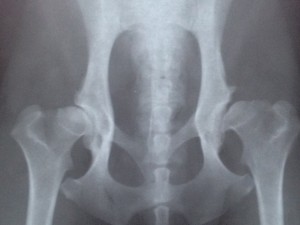Have you watched in dismay as your dog struggles to hop into the car, or groans when rising from an afternoon snooze?
If you’ve had to deal with hip dysplasia (HD) with your dog, the video at the end of this post may bring back some familiar memories. If not, consider yourself, and your dog, very fortunate. While many pet owners may never need to concern themselves with this dibilitating disease, those that do will never forget the battle.

You most likely recognize the ravages of hip dysplasia, and are not excited by the prospects of traditional surgical treatments. So what are your options when faced with a dysplasia diagnosis?
Why is a dysplasia diagnosis is so grim
Hip dysplasia is a degenerative disease that can be inherited or result from injury or environment. Regardless of cause, the mis-alignment of the hip joint leads to painful arthritis and lameness. Traditional treatments consist of invasive surgical procedures including hip replacement, reconstructive surgery or amputation.
What if you prefer a less invasive approach?
A new, less invasive treatment option is gaining popularity, which uses your dog’s own stem cells to regenerate the joint being destroyed by dysplasia. The procedure involves removing some fat tissue from your dog and separating out the stem cells. The cells can be “harvested” within 24 hours.
Your vet then implants some of the stem cells in the hip joint in a short followup procedure. These cells begin to create an anti-inflammatory environment and can regenerate bone, muscle and connective tissue. . The entire procedure is done in your vet’s clinic, provided they have been certified for the technique. Some of the stem cells can be “banked” in the event further treatments are needed.
What are these Stem Cells?
You’ve most likely heard about stem cells. These are the cells a body uses to make other cells, which then divide to create more cells.
These new cells can form new cells matched to the job they are needed to perform. Unlike the controversial embryonic stem cells in the news, all animals possess the type of “mature” stem cells which are used in this procedure.
Stem cell implantation for dogs has been growing in popularity and shrinking in cost. When initially introduced more than a decade ago, it was necessary to send the cells to an outside lab for harvesting. Recent advances have streamlined that process so the entire procedure can now be performed in-house, like any traditional surgical option.
Stem Cell Therapy can be performed in a single day, just like Traditional Treatments
The contrasts to traditional surgical procedures are striking.
Recovery time is greatly reduced, and the cost of the procedure is comparable or less than traditional surgery. Anesthesia is needed to sedate the dog during the removal of fatty tissue, but not for implantation of the stem cells. There are no large incisions to heal, and no other drugs are needed for the procedure.
Clinics can now harvest stem cells without sending them out and waiting for their return. This procedure can be done immediately upon removal of the fat tissue, so implantation can be done during the same visit.
Instead of the months of limited mobility and healing required for a hip replacement or other surgery, results from stem cell implants may be seen within days.
One vet who has begun offering the procedure in his practice feels the “greatest post-op concern is that animals feel so well that they can re-injure themselves by becoming active too soon”. The cost of traditional surgical methods is often comparable, or more expensive, than the cost of stem cell therapy.
So, should you consider Stem Cell Therapy?
Stem cell therapy has shown a high success rate, as do most hip replacements and other surgeries. While relatively new, this approach shows promise as an alternative to be considered when available and appropriate. As a follow up therapy for a previously failed surgery, it offers yet another option.
It is not recommended in cases where a dog is fighting cancer, or infection, since it may interfere with the immune system. Since the procedure is relatively new, long term results are not yet available.
Indications are that the treatment is effective, and can be “renewed” with additional injections. It is a different and welcome approach to pain management without constant medication.
A Case Study: watch one pet owner’s experience using this approach

Leave a Reply